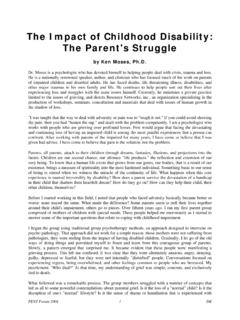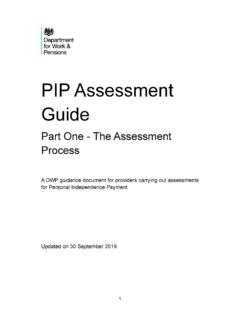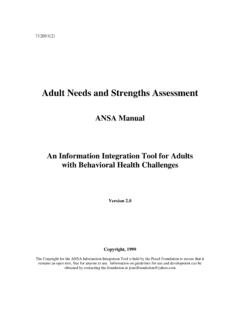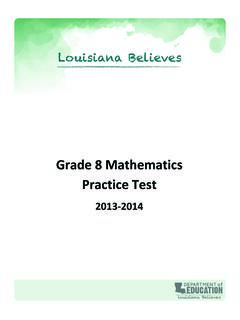Transcription of Functional Assessment Observation Form - California
1 Functional Assessment Observation form THE CONTENT OF THE Functional Assessment Observation form This Functional Assessment Observation form has eight major sections (see next page). A blank copy of the form is included on page 9. Each labeled section is described below. This form combines an event-recording system with hypothesis generation. Once learned, it can provide a streamlined data collection system that implementers value and use SECTION A: IDENTIFICATION/DATES In Section A, you show who is being observed and the dates on which the data are being collected. Note that a single page can be used across multiple days.
2 Section B: Time Intervals Section B is separated into blocks that can be used to designate specific intervals (1 hour, a half-hour, 15 minutes). List here the periods and settings/activities in which Observation is taking place. These can be arranged in a variety of ways, depending on a person s daily schedule. For a school student you might list class period times and content (for example, 8:30-9:00, Homeroom; 9:05-9:50, Language Arts; 9:55 - 10:40, Computer; 11:45-12:30, Lunch; 1:25-3:00, Job Training). For an adult in a less structured home setting, you might simply list time periods (3:00-4:00; 4:00-5:00; 5:00-6:00).
3 Depending on a person s typical pattern of behavior or typical schedule, you may want to use unequal interval periods within the blocks, such as 15-minute intervals during busy morning routines and two-hour intervals during the evening when problem behaviors are much less frequent. If targeted behaviors are very frequent during a particular time period or activity, multiple blocks can be used to record data for that period. A row for summarizing total frequencies of behaviors or incidents is labeled at the bottom of the form . Section C: Behaviors In Section C, list the individual behaviors you have identified for monitoring during the observations.
4 These targeted behaviors should be the ones identified during your interviews with relevant people. You may also decide to list positive behaviors such as appropriate communication responses or attempts that seem important to document or are of interest. The form allows flexibility in monitoring behaviors. For example, if a particular behavior (eye-poking or aggression) occurs in both low-intensity and high-intensity forms, you can list each form as a separate behavior to identify differences or similarities in their patterns of occurrence. When several behaviors occur regularly in combinations, you may monitor them all within a single behavior notation (dropping to the floor, screaming, kicking feet and flailing arms to pound the floor may all be recorded under tantrum).
5 However, be cautious about grouping behaviors together for coding. One of the more useful pieces of information obtained through the FAO is the individual behaviors that tend to occur together and those that do not. Initial perceptions that certain behaviors always go together may not always be supported by direct Observation data. 1 Text and forms adapted from Functional Assessment and Program Development for Problem Behavior (second edition), by Robert E. O Neill, Robert H. Horner, Richard W. Albin, Jeffrey R. Sprague, Keith Storey, and J. Stephen Newton (Belmont, Calif.)
6 : Wadsworth Publishing Co., 1997, pp. 37-44), by permission of the publisher. The BIP Desk ReferenceSee 3 Page 26 of 58 The BIP Desk ReferenceSee 3 Page 27 of 58 Section D: Predictors In Section D, list important events or stimuli identified in your interviews as potential predictors for the occurrence of problem behaviors. Such events typically are present or occur just before or at the same time as the problem behaviors. The FAO form already lists several potential predictors that have often been found in the research literature and in the authors clinical experiences to be related to the occurrence of problem behaviors.
7 These are Demands/Requests, Difficult Tasks, Transitions (place to place or activity to activity), Interruptions, and being left Alone (no attention). Additional empty slots are provided for you to list potential predictors specific to the person being observed. These might include the names of different support persons present; particular activities or tasks; conditions such as noise, schedule changes, or confusion; and the presence of particular classmates, housemates, or co-workers. You might also label a column Don t Know or Unclear to be used when the person recording data cannot identify particular setting events or antecedent stimuli that may be related to the occurrence of problem behaviors.
8 Section E: Perceived Functions In Section E, we ask observers to make their best guess regarding what they perceive as the apparent function of behaviors that occur during an incident. In other words, note why you think the person did what he or she did. This section has two major areas: obtaining desired things and escaping/avoiding undesired things. The specific things that would be designated on the form would depend on information gathered during the interview process. However, as in the Predictors section, the form lists several outcomes that individuals have been interested in obtaining or escaping through problem behavior.
9 These outcomes include obtaining attention, specific items or activities (you might list specific items or activities), and self-stimulation; and escaping or avoiding demands/requests, specific activities, or people. A column for Don t Know is included for situations in which observers are unsure of possible functions of the behavior observed. Focusing on the particular outcome of a behavior and judging its function may be somewhat new ideas for many observers. People are often more accustomed to attributing the occurrence of problem behaviors to a person s personality traits or disability labels (for example, she likes to hurt people because she is mean, he does that because he is angry, he does that because he has autism ).
10 Because of this tendency, some observers may need repeated explanations and extra help to understand the important purpose of this section. We believe it is more respectful of a person s dignity to assume that Functional reasons exist for problems behaviors rather than to think that such behaviors occur because of some personal trait or characteristic that is unchangeable. Section F: Actual Consequences In Section F, you record data on the actual consequences that follow problem behaviors for example, the person was told no, was ignored, was redirected. This information gives you some idea of the consistency with which certain consequences are being provided.













